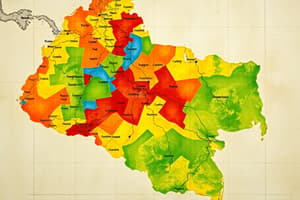Podcast
Questions and Answers
Why are people considered a resource?
Why are people considered a resource?
People are the greatest resource of a nation. All other resources of nature become significant only when people extract their usefulness. It is people with their demands and abilities that turn them into resources. Hence, human resource is the ultimate resource.
What are the causes for the uneven distribution of population in the world?
What are the causes for the uneven distribution of population in the world?
Population distribution in the world is uneven because of two factors, Geographical and Social.
Which of these options are geographical factors that contribute to population distribution?
Which of these options are geographical factors that contribute to population distribution?
- Topography (correct)
- Social factors
- Water (correct)
- Economic factors
Explain how topography influences population distribution.
Explain how topography influences population distribution.
Explain how water influences population distribution.
Explain how water influences population distribution.
Which of these are social factors that contribute to population distribution?
Which of these are social factors that contribute to population distribution?
Explain how economic factor influence population distribution.
Explain how economic factor influence population distribution.
Why has the world population grown rapidly?
Why has the world population grown rapidly?
Which two factors influence population change?
Which two factors influence population change?
Explain what the birth rate and death rate are.
Explain what the birth rate and death rate are.
Explain how the birth rate and death rate determine population growth.
Explain how the birth rate and death rate determine population growth.
What is meant by population composition?
What is meant by population composition?
What are population pyramids? How do they help in understanding the population of a country?
What are population pyramids? How do they help in understanding the population of a country?
What does the term 'population distribution' refer to?
What does the term 'population distribution' refer to?
Which of the following are the three main factors that cause population change?
Which of the following are the three main factors that cause population change?
In 1999, the world population reached:
In 1999, the world population reached:
What is a population pyramid?
What is a population pyramid?
When people are attracted to an area, it becomes ____ populated. Factors that influence this include ____ climate, good supplies of ____ resources, and ____ land.
When people are attracted to an area, it becomes ____ populated. Factors that influence this include ____ climate, good supplies of ____ resources, and ____ land.
Flashcards
Human Resource
Human Resource
The most important resource of a nation; people with the ability to transform natural resources into useable products.
Uneven Population Distribution
Uneven Population Distribution
The unequal spread of people across the Earth, affected by geographical and social factors.
Geographical Factors (population)
Geographical Factors (population)
Elements of the physical environment that influence population distribution (e.g., topography, water availability).
Topography (population)
Topography (population)
Signup and view all the flashcards
Water Availability (population)
Water Availability (population)
Signup and view all the flashcards
Social Factors (population)
Social Factors (population)
Signup and view all the flashcards
Densely Populated
Densely Populated
Signup and view all the flashcards
Sparsely Populated
Sparsely Populated
Signup and view all the flashcards
Population Growth
Population Growth
Signup and view all the flashcards
Birth Rate
Birth Rate
Signup and view all the flashcards
Death Rate
Death Rate
Signup and view all the flashcards
Natural Growth Rate
Natural Growth Rate
Signup and view all the flashcards
Population Pyramid
Population Pyramid
Signup and view all the flashcards
Population Composition
Population Composition
Signup and view all the flashcards
Population Distribution
Population Distribution
Signup and view all the flashcards
Population Change
Population Change
Signup and view all the flashcards
Study Notes
Human Resources
- People are the most important resource of a nation. Natural resources become valuable only when people utilize them.
- Population distribution is uneven globally due to geographical and social factors.
Geographical Factors
- Topography: Flat plains are preferred for farming, manufacturing, and service industries, making areas like the Ganga Plains densely populated. Mountains and plateaus are less populated.
- Water Availability: Areas with readily available fresh water, such as river valleys, have higher population densities compared to deserts.
Social Factors
- Better Amenities: Areas with good housing, education, and healthcare facilities attract more people, leading to higher population densities.
- Economic Opportunities: Industrial areas with employment opportunities draw large numbers of people, resulting in dense populations (e.g., Mumbai, India; Osaka, Japan).
Population Growth
- Science and technology have led to significant increases in food production and improvements in healthcare, resulting in decreased death rates and rapid population growth.
- Population change is influenced by birth and death rates. A higher birth rate than death rate results in population growth. The difference between birth and death rate is called the natural growth rate.
Population Composition
- Population composition shows the structure of a population (e.g., age groups, sex, education, occupation, income levels).
- Population pyramids are graphical representations of population composition in terms of age groups and sex.
- Pyramids showing broad bases and narrow tops indicate high birth and death rates.
Factors Affecting Population Distribution
- Favorable climate, availability of resources, and fertile land make a region attractive to people.
- Population density may be extreme, densely or sparsely populated depending on factors like, climate, good supplies of resources and land..
Studying That Suits You
Use AI to generate personalized quizzes and flashcards to suit your learning preferences.




